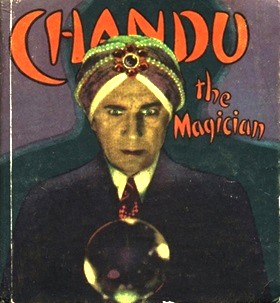
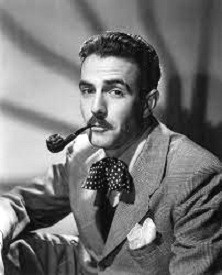 Chandu, the Magician (1932-35, 1948-50) aired “The Black Steps” on February 3, 1949 as the 1st of the 13 half-hour episodes that began in February to begin the 1949 season that would then run until May when the summer hiatus would intervene until the show would pick up again with its final 6 episodes in November and its 1949 season on Christmas Eve. This is only the 4th episode of Chandu we’ve offered since the first in April of 2023 and the first since June of 2024.
Chandu, the Magician (1932-35, 1948-50) aired “The Black Steps” on February 3, 1949 as the 1st of the 13 half-hour episodes that began in February to begin the 1949 season that would then run until May when the summer hiatus would intervene until the show would pick up again with its final 6 episodes in November and its 1949 season on Christmas Eve. This is only the 4th episode of Chandu we’ve offered since the first in April of 2023 and the first since June of 2024.
The first run (1932-35) consisted of daily 15-minute episodes that became popular very quickly, so much so that a 1932 film soon followed the radio adventures of Chandu. The idea behind Chandu the Magician stemmed from the public’s interest at the time with Eastern mysticism and the occult. The Chandu character’s fictional real life name is Frank Chandler. Chandler has spent many years in the Orient studying the mystic arts and is now adept at astral projection, conjuring illusions, and teleportation among other magical abilities he uses when necessary. If this sounds like a familiar set of superpowers it was, witness magazine and radio close contemporaries like the Shadow or Mandrake the Magician—though Chandu on radio was the first. The original story arc sees Chandu chasing after the evil Roxor, who has kidnapped the husband of Chandu’s sister, Dorothy Regent. Chandu and his sister travel to all sorts of exotic locales in search of her husband (who was thought to have disappeared in a shipwreck but later to have disappeared at the hands of Roxor). Roxor, as all truly evil villains are, is bent on conquering the 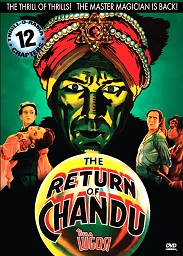 world and will stop at nothing to accomplish his egomaniacal ends. For the original 1932 movie, actor Edmund Lowe played Chandu, while none other than Bela Lugosi took the role of Roxor. For the 1934 sequel, however, in a surprising role reversal Lugosi was honored with the role of Chandu.
world and will stop at nothing to accomplish his egomaniacal ends. For the original 1932 movie, actor Edmund Lowe played Chandu, while none other than Bela Lugosi took the role of Roxor. For the 1934 sequel, however, in a surprising role reversal Lugosi was honored with the role of Chandu.
A crucial bit of the history of the show would be incomplete without mentioning that a great part of the radio show’s success was due to a young woman by the name of Vera Oldham, a former office girl who proved good on her aspirations to write. After the radio series ended in 1935 and the Chandu films were long over, Chandu was resurrected on radio in 1948, with the former story arc refurbished and updated (even bringing back Oldham to touch up the scripts), continuing Chandu’s travels to mysterious and little known parts of the world (the fabled land of Lemuria for one), and gifting him with a love interest of surpassing beauty in the character of the Egyptian princess Nadji.
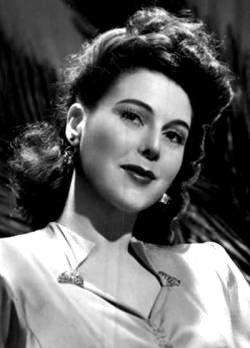
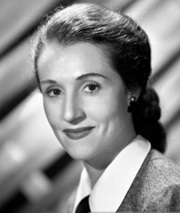 For the 1948-50 radio revival, the episodes from June of 1948 through the end of January 1949 were daily 15-minute episodes, then from February of 1949 through the final show on September 6, 1950 Chandu would become full half hour, self-contained stories, of which this week’s episode is one. Tom Collins (1913-73, photo top right) would become the new voice of Chandu, Irene Tedrow (1907-1995, photo at right) played his sister Dorothy, and film actress Veola Vonn (1918-1995, photo at left) was Princess Nadji. While Dorothy appears in this episode, Princess Nadji does not. Besides her dual careers in radio and film, Tedrow would also make a name for herself in television, appearing in dozens of shows, a very few among them being Dennis the Menace (1959-63, 26 episodes as Mrs. Lucy Elkins), Dragnet, Leave it to Beaver, The Twilight Zone (episode “Walking Distance” from October 30, 1959; ranked as the 9th best TZ episode of all time), Perry Mason, Wagon Train, Bonanza, The Andy Griffith Show, The Fugitive, Hogan’s Heroes, Kung Fu, Magnum P.I., L.A. Law, and a veritable host of others. In 1939 Tedrow married William Kent, a refugee who came to the United States to escape Nazi Germany. He passed away in 1974. Tedrow died on March 10, 1995 in Hollywood from complications arising from a stroke. She was 87.
For the 1948-50 radio revival, the episodes from June of 1948 through the end of January 1949 were daily 15-minute episodes, then from February of 1949 through the final show on September 6, 1950 Chandu would become full half hour, self-contained stories, of which this week’s episode is one. Tom Collins (1913-73, photo top right) would become the new voice of Chandu, Irene Tedrow (1907-1995, photo at right) played his sister Dorothy, and film actress Veola Vonn (1918-1995, photo at left) was Princess Nadji. While Dorothy appears in this episode, Princess Nadji does not. Besides her dual careers in radio and film, Tedrow would also make a name for herself in television, appearing in dozens of shows, a very few among them being Dennis the Menace (1959-63, 26 episodes as Mrs. Lucy Elkins), Dragnet, Leave it to Beaver, The Twilight Zone (episode “Walking Distance” from October 30, 1959; ranked as the 9th best TZ episode of all time), Perry Mason, Wagon Train, Bonanza, The Andy Griffith Show, The Fugitive, Hogan’s Heroes, Kung Fu, Magnum P.I., L.A. Law, and a veritable host of others. In 1939 Tedrow married William Kent, a refugee who came to the United States to escape Nazi Germany. He passed away in 1974. Tedrow died on March 10, 1995 in Hollywood from complications arising from a stroke. She was 87.
“The Black Steps” is a fitting first episode to the start of the full half-hour shows in that it begins in India and provides background history as to Chandu’s origins. The opening scene in the hidden depths of India finds Chandu called before his religious teacher, a yogi, seated at a table with a crystal ball featured prominently before him. After explaining to Chandu that a dark shadow is soon to cover the Earth and that it is time for him to leave, the interior of the crystal ball comes alive with a scene that sets the stage for the rest of the episode, a dire vision showing Chandu’s sister, an unknown stranger, and an evil man named Roxor who is scheming to find a secret formula created by Chandu’s sister’s missing husband, a prominent chemist during the war but whose whereabouts and fate have been unknown even now, years after the war has ended. This Roxor person will stop at nothing to gain the formula that will be the final piece of the puzzle in his machinations to rule the world, but Roxor’s surrogate must first travel to California, and after ingratiating himself as a harmless individual, arrange a meeting with Chandu’s sister in order to hopefully get a clue to the formula’s location, if indeed her missing brother has hidden it within their home before his disappearance. Before such a plan is allowed to develop, Chandu must travel the long distance from India to California before it is too late, but such a feat must put to the test one of the occult teachings of his time in India, namely that time and space are but illusions and the mastery of a form of material transference a reality. Appearing miraculously at his sister’s home, where the seemingly harmless stranger and a few others are in attendance, Chandu (now as Frank Chandler) begins putting together the clues necessary to beat his enemy to the hidden papers containing the secret formula that Roxor desires above all else. One thing leads to another in unlikely succession and before we realize what is happening we find ourselves in faraway Egypt, in an undiscovered tunnel far beneath the Sphinx, where we are helpless and unwilling witnesses to dark sorcery more than 6,000 years old. What dire secrets dare we seek to learn from this sorcery and what has this to do with Frank’s brother’s now lost formula? With the over-arching, creepy atmosphere of ancient evil pervading most of this episode, a story reminiscent of the sort that made Weird Tales the iconic magazine of the supernatural that it came to be, to learn the meaning of “The Black Steps” you have only to sacrifice a mere 30 minutes of your mortal lifespan and the answer will be revealed.
Play Time: 29:14
{Airing on a Thursday evening in early February of 1949, the timing couldn’t have been more perfect for the neighborhood gang, for they had only to survive one more intolerable day of school before heading for the nearby newsstand to collect more tales of adventurous thrills to last them the weekend. All-Story Detective (1949-51) lasted for only 15 issues with the first 6 bearing the title below. The final 9 issues saw the title changed to 15-Story Detective. It was probably best known for the John D. MacDonald stories it ran. It was a bi-monthly during its brief run. Super Science Stories (1940-43 & 1949-51), though it struggled through two brief incarnations, never seemed to find a secure home even though it offered stories by major names in the field (Ray Bradbury and Henry Kuttner but two just on the issue shown below). While also a bi-monthly it managed only 5 issues in 1949. 10-Story Detective (1938-49) focused on police and detective action fare, and was at least popular enough to make a decent run of 11 years. It was a bi-monthly, with the issue below being the first of four in its final year.}
[Left: All-Story Detective, 2/49 – Center: Super Science Stories, 1/49 – Right: 10-Story Detective, 2/49]



To view the entire list of weekly Old Time Radio episodes at Tangent Online, click here.